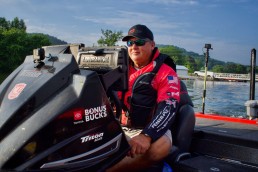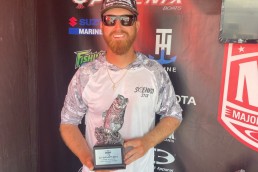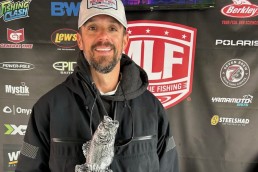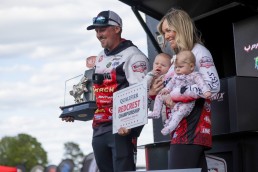Eelgrass Education with Terry Scroggins
Courtesy of Luke Stoner – Dynamic Sponsorships
Iconic Lake Guntersville is the playing field this week for Toro Stage Four of the Bass Pro Tour here in northeast Alabama. Few fisheries have as much history in terms of high-level bass fishing tournaments as this legendary reservoir on the Tennessee River.
Certain aspects of Guntersville have remained consistent, like the abundance of big largemouth bass and the incredible fishing community surrounding the lake, but the consensus among BPT competitors after official practice was that Lake Guntersville is a completely different fishery than what many are used to.
“This won’t be the same offshore dominated, Tennessee River ledge type beatdown that we used to expect when we came to Guntersville in mid-May,” Terry Scroggins said. “This lake is now absolutely full of a type of eelgrass. I mean it is everywhere, from two feet to twelve feet deep, and it has completely changed what we’ve come to expect about Gville.”
Team Toyota’s Terry Scroggins calls the St Johns River in Florida home, and has as much experience fishing around eelgrass and other aquatic vegetation as anyone. We picked Big Show’s brain on how the presence and abundance of eelgrass will affect the fishing this week.
The positives
Eelgrass is also referred to as tape grass or wild celery and is defined as, “any of several submerged aquatic monocotyledonous plants (genus Vallisneria of the family Hydrocharitaceae) with long ribbonlike leaves.” And according to Scroggins, eelgrass has several positive aspects that have already benefitted this famed fishery.
“This lake gets as much pressure as anywhere but the presence of all this eelgrass allows fish to spread out and hide from that pressure a lot better,” Scroggins said. “In the last ten years when the fish would get offshore, they would get torched because they were easy to find with modern electronics, but that’s all changed. A lot more fish are staying shallow, and the ones out deep aren’t grouping up quite the same.”
Scroggins explained the eelgrass has really opened the fishing up here for the summer months and puts more techniques in play versus the typical shad spawn followed by an offshore structure heavy tournament like we’ve seen playout so many times on Lake Guntersville. Expect the shallow fish to be healthier than years past and for there to be more of them caught during Stage Four.
“Eelgrass also serves like a filtration system for the water,” Scroggins said. “It helps clean the lake up after it muddies and has made the water way clearer here on Guntersville. Some anglers might not like that, but better water quality with more places to hide will ultimately just make this a better lake. There is so much life in this place right now.”
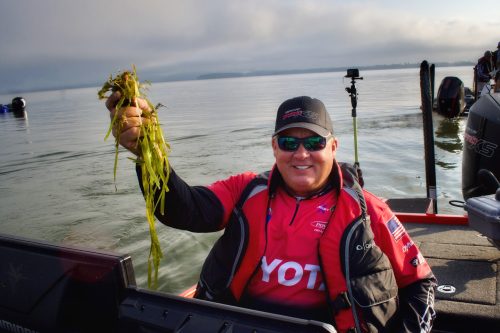
The challenges
While eelgrass has predominantly had a positive effect on Guntersville, the abundance of the long-leaved perennial presents certain challenges for anglers, too. Bass love grass, but anyone who has fished around ‘too much grass’ knows it can be frustrating to fish.
“This eelgrass isn’t attached to the bottom like the stuff I am used to in Florida,” Scroggins explained. “There is a lot of floating eel grass here on Guntersville and that makes it nearly impossible to fish some areas, especially offshore spots, if you are trying to wind something like a big crankbait. I’m not saying you can’t catch them offshore, you can, the grass has definitely changed that deal.”
Scroggins Toyota teammate Kevin VanDam, who has used his Strike King XD series of crankbaits to win a pile of money from the famed Lake Guntersville ledges over the years, said he only made a handful of casts with a plug in practice due to the abundance of grass. VanDam said it’s simply hard to fish many moving baits effectively with all the floating eelgrass.
“Over time the eelgrass will just make this lake better, but you will hear some anglers cussing it this week, too,” Scroggins laughed. ““Eelgrass is good for the health of a lake because it spreads the fish out but that makes it harder for us to find bass and fish the areas affectively. It’s a positive and a negative at the same time, but the fish still live here big time and these boys will show out like they always do.”
